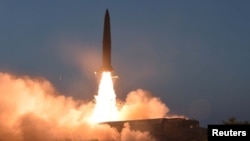북한이 최근 공개한 신형 단거리 탄도미사일은 러시아가 직접 기술을 지원했을 가능성이 크다는 분석이 나왔습니다. 발사 횟수에 비해 성공률이 이례적으로 높기 때문입니다. 김동현 기자가 취재했습니다.
북한은 관영매체를 통해 최근 발사한 탄도미사일의 성능이 만족스럽게 검증됐다고 자평했습니다.
[녹취: 조선중앙TV 지난달 26일 보도] “위력 시위 사격을 통해 신형 전술 유도무기체계의 전투적 성능 지표들이 다시 한번 만족스럽게 검증됐다”
이 주장이 사실이라면, 북한은 지난 5월 처음 공개한 뒤 단 3차례 만에 비행 시험발사에 성공한 게 됩니다.
이 미사일은 저고도 활공비행을 하는 특성 때문에 러시아가 2000년대 초반 개발한 최신형 이스칸데르 미사일 SS-26을 북한이 제3국에서 수입해 역설계했을 가능성이 거론됩니다.
하지만, 독일의 미사일 전문가인 마커스 실러 박사는 VOA에, “최근 북한이 공개한 신형 무기들은 모두 시험 횟수에 비해 상당한 성공률을 보이고 있다”며, 자체 역설계가 아닌 러시아의 직접 기술 제휴 가능성이 높다”고 말했습니다.
[녹취: 마커스 실러 박사] “My question is how can they quickly achieve success like that where others had to put something around 10~15 years of work into that and the North Korea they always come out of the blue and successful and yes I think they still must have some kind of external help”
이스칸데르 SS-26의 경우 러시아가 1990년대 개발을 시작해 실전에 투입하기까지 약 15년이 걸린 점을 감안하면, 북한의 실험 횟수는 턱없이 적다는 설명입니다.
실러 박사는 러시아가 북한의 신형 탄도미사일 개발에 직접 관여했을 가능성이 큰 것으로 추정했습니다.
[녹취: 마커스 실러 박사] “The Iskander as you said, is a sophisticated weapon system and it was introduced in the mid 2000 in Russia and basically it is the successor of the successor of the SCUD missile.. It took them from the early 1990s to the mid 2000. 15 years to finally have that weapon system operational and to launch it in the Georgian War in 2008 the first time.”
실러 박사가 지난 2월 국제학술지 ‘사이언스 앤 글로벌 시큐리티’에 게재한 논문에 따르면 미국과 러시아 등은 탄도미사일 개발 성공까지 최소 10회 이상의 비행 실험을 했습니다.
하지만 북한은 무수단 미사일 등 최신 무기체계 비행 실험이 모두 10회 미만이었고, 이는 “미사일 개발 사상 유례가 없는 통계”라는 게 실러 박사의 평가입니다.
이 때문에 이번 미사일뿐 아니라, 최근 공개한 신형 무기 전반에 걸쳐 러시아의 직접적인 기술 유입이 의심된다고 실러 박사는 밝혔습니다.
하버드-스미스소니언 천체물리학센터의 조너선 맥도웰 박사는 러시아의 직접 기술 제휴 가능성은 미국 학계에서도 논쟁적인 사안이라고 말했습니다.
다만, 러시아가 1957년 세계 최초 인공위성인 스프투닉 1호 발사에 성공하기 전까지 서방국들이 인공위성 역량을 오판했던 사례를 들며, 자체 개발 역량이 없다고 단정짓기는 아직 이르다고 덧붙였습니다.
[녹취: 조너선 맥도웰 박사] “That has always been the argument for 20 years. So what extent is North Korea able to do its on its own and to what extent do they have perhaps former soviet engineers who decided to make a good living helping out the North Koreans. That is unclear. I think there is a danger here that the it reminds me of the attitude in the United States that the Russian could not build Sputnik by themselves, it must’ve been the German rocket engineers that were doing it for them”
이에 대해 실러 박사는 스프투닉도 실제 발사 성공까지 6번의 실험이 있었다며, 인공위성 정찰 능력이 발달된 현대의 기술로는 사전에 개발 정황을 포착했을 것이라고 말했습니다.
또 북한이 자체 역량으로 실험에 성공했다면, 미사일 개발 특성상 실패 횟수는 필연적이지만, 엔진 성능 실험 등의 활동이 적다고 지적했습니다.
[녹취: 마커스 실러 박사] “Well back in the time of Sputnik the Soviet Union was clearly underestimated. But we didn’t have such a good idea what is actually going on Soviet Union at that time. If we had spy satellite such as we see now we would have seen huge areas where they are working on rockets, on the engines, we would see a lot of static engine firings, we would see a lot of launches of test vehicles. Sputnik flight was actually 5th or 6th attempt of launching the 7 missiles… So we would have seen 6 attempts before that”
토머스 카라코 전략국제문제연구소 CSIS 미사일 방어 프로젝트 국장도 VOA에, “북한은 2000년대부터 다양한 미사일 기술을 선보이고 있다”며, “외부로부터 상당 수준의 직접적인 기술 제휴 없이 자체 역량 만으로 개발에 성공했을 것으로 상상하기 어렵다”고 말했습니다.
[녹취:토마스 카라카코 국장] “A lot of missile technologies have been shown up for a relatively short period of time. Like new missiles, over a relatively short period of time. It is hard to imagine North Korea has done this all by themselves without some substantial assistance”
게리 세이모어 전 백악관 대량살상무기 담당 조정관은 VOA에, “최근의 신형 미사일을 포함해 북한의 미사일이 러시아로부터 왔다는 정황 증거는 여러 차례 포착됐었다”고 말했습니다.
[녹취: 게리 세이모어 전 조정관] “There has been some indications technology for the missile may have come from Russia at some point same with the Iskander but it is very hard to tell how much North Korea’s missile technology has been acquired from Russian scientist or engineers at the end of the cold war”
그러나 세이모어 전 조정관은 북-러 사이에 구체적으로 어느 시점에 어느 정도의 기술 제휴가 이뤄졌는지는 판단하기 어렵다고 말했습니다.
VOA 뉴스 김동현입니다.





![[인터뷰: 미사일 전문가 이언 윌리엄스] “북한 미사일, 새로운 영역으로 진화…기존 모델과 연결고리 없어”](https://gdb.voanews.com/d9d763e2-c041-45b9-a7a0-de06c3836ef1_cx16_cy5_cw63_w33_r1.jpg)
![[인터뷰: 미사일 전문가 제프리 루이스] “북한 미사일, 역내 미사일 방어망 무력화…미군기지 등 위협”](https://gdb.voanews.com/4b454f07-a7af-40aa-aba6-308df5a4947c_cx0_cy17_cw0_w33_r1.jpg)
